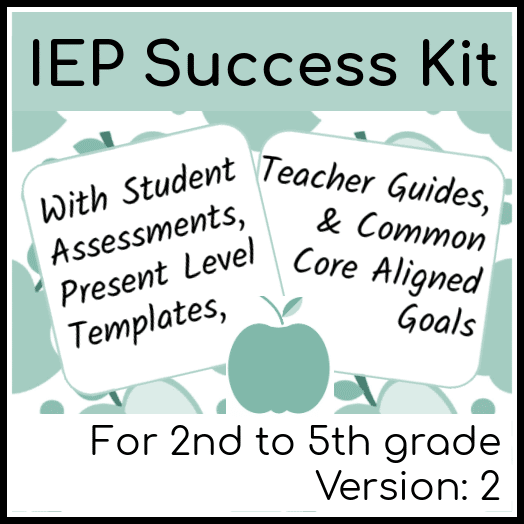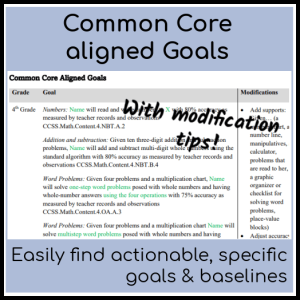IEP Writing Success Kit: Upper Elementary Version 2 with Special Education Assessments & Goals
$14.99
Version 2 of the Mid- to Late-Elementary IEP Success Kit helps you work smarter, not harder on your IEPs! To learn more about the kit, check out the preview here!
Description
Work Smarter, Not Harder
If IEP writing is a task you dread or that consumes your hours after work and on the weekends, then the IEP Success Kit is for you! The goal of the IEP Success Kit is to help you write even stronger IEP present levels (PLOPs or PLAAFPs) and goals while saving time.
This kit is for students working at a mid- to late-elementary level, grades 2 through 5. It includes:
- Comprehensive student assessments in reading, writing, and mathematics
- A detailed teacher’s guide with additional academic assessments, scoring guides, and IEP friendly score reporting language
- An editable set of present levels templates for reading, writing, and mathematics
- An IEP goal bank with present levels examples, Common Core aligned goals for Kindergarten through fifth grade, and tips on how to modify the goals to make them work for your students.
Why Buy?
Each component of the kit has been tailor designed to create a seamless IEP writing experience. The student assessments flow to the present levels and the present levels to the goals to save you, and your students, time. There are assessments, goals, and present levels language in this kit for students who are just learning letters and numbers and ones for students who can read at a first grade level and solve addition and subtraction problems on their own. You pick and choose the assessments, the goals, and the type of templates that work for you and for your student!
Note that this is Version 2 of the Mid- to Late- Elementary kit. Versions 1 and 2 have the same exact assessments but with different content (like words, problems, stories, etc.,) so that you can use one for annual IEPs and informal assessments and the other for progress reporting and interim assessments—or just so not all students are seeing the same exact problems!
What Do You Get?
- For reading you get:
- Assessments, including: fiction and nonfiction reading comprehension stories; Dolch sight words assessments; phonics based decoding assessments
- Scoring guides, including: IEP friendly language for what students CAN do in each of those areas, not what they can’t do. Can they decode CVC words? Can they identify the broad topic of a non-fiction passage?
- Present level examples and templates for decoding and comprehension at three different levels (from PreK through 5th grade)
- Common Core aligned IEP goals in decoding/word recognition and comprehension from Kindergarten to 5th grade
- For writing you get:
- Assessments, including: spelling sounds assessments; writing fluency activities; narrative writing prompts; paragraph writing activities; editing assessments
- Scoring guides including: IEP friendly language for what students CAN do in each of those areas, not what they can’t do. Can they write a topic sentence or add details to a paragraph? Can they put a capital letter at the beginning of their writing and a period at the end?
- Present level examples and templates for emergent, transition, and fluent writers with explanations on how the assessments fit into the present levels
- Common Core aligned IEP goals in spelling, story writing, writing stamina, and grammar for Kindergarten to 5th
- For mathematics you get:
- Assessments, including: number identification and writing; word problems with all four operations; addition and subtraction assessments from facts to regrouping; multiplication and division assessments, including multiplication facts; number sense activities including ordering numbers, expanded form, and rounding; advanced mathematics problems including decimals, fractions, and algebraic problems.
- Scoring guides including: IEP friendly language for what students CAN do in each of those areas, not what they can’t do. Can they solve multiplication facts with a multiplication chart? Can they use drawings to solve one-step addition fact word problems with straight forward language?
- Present level examples and templates at four levels for students just learning numbers, just learning addition and subtraction, learning multiplication and division, and for those at a more advanced level.
- Common Core aligned IEP goals in word problems, addition and subtraction, and number sense, with tips on how to modify the goals.
The Fine Print
- The Goal Book and Present Levels examples are the same across all levels and versions to make them easier to use and to customize. The assessments and teacher’s guide are what changes.
- The assessments are comprehensive, except that they do not include a DRA or similar assessment, which we recommend giving in addition to these assessments.
- The present levels templates are very thorough, as are the assessments. Not every assessment or present level component makes sense for every student! Pick and choose what makes sense for your student—you are the expert on your students!
Need Interventions?
- If you are looking for Common Core aligned interventions that match the goals and assessments in the success kit, check out the store! For writing, we have writing fluency, descriptive writing, and complete sentences interventions. For mathematics, we have word problem and computation interventions from addition facts to long division. Reading interventions are coming soon!
Returns & Refunds
- Not sure the product is right for you? See the store’s refund and returns policy— and try the product risk free for thirty days!
You must be logged in to post a review.













Reviews
There are no reviews yet.